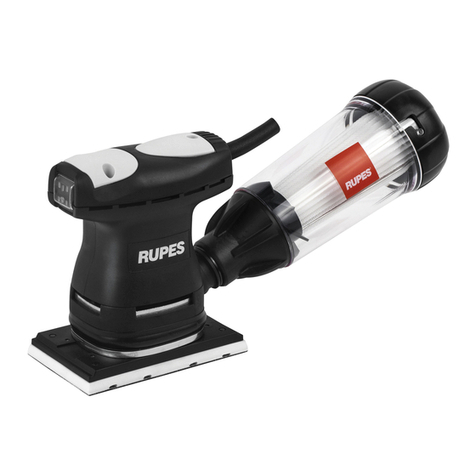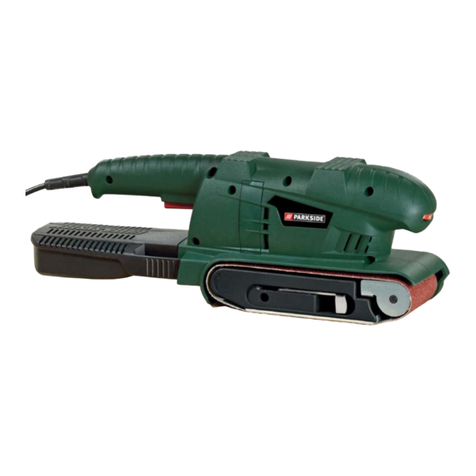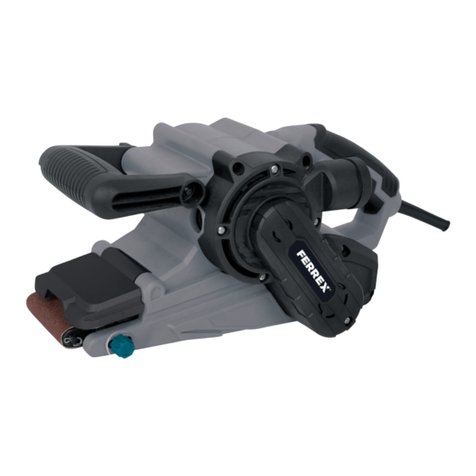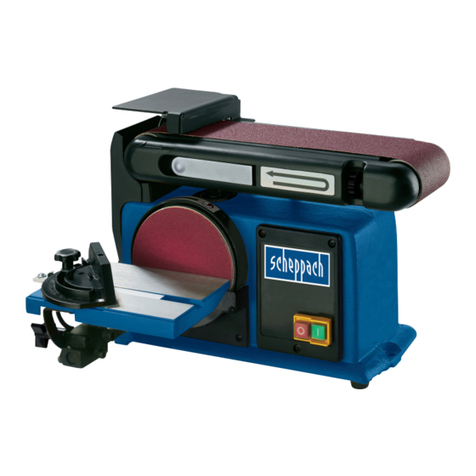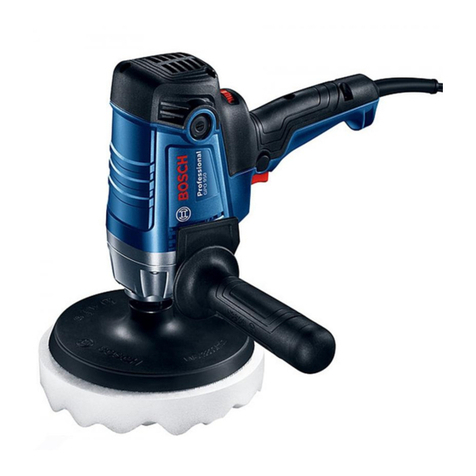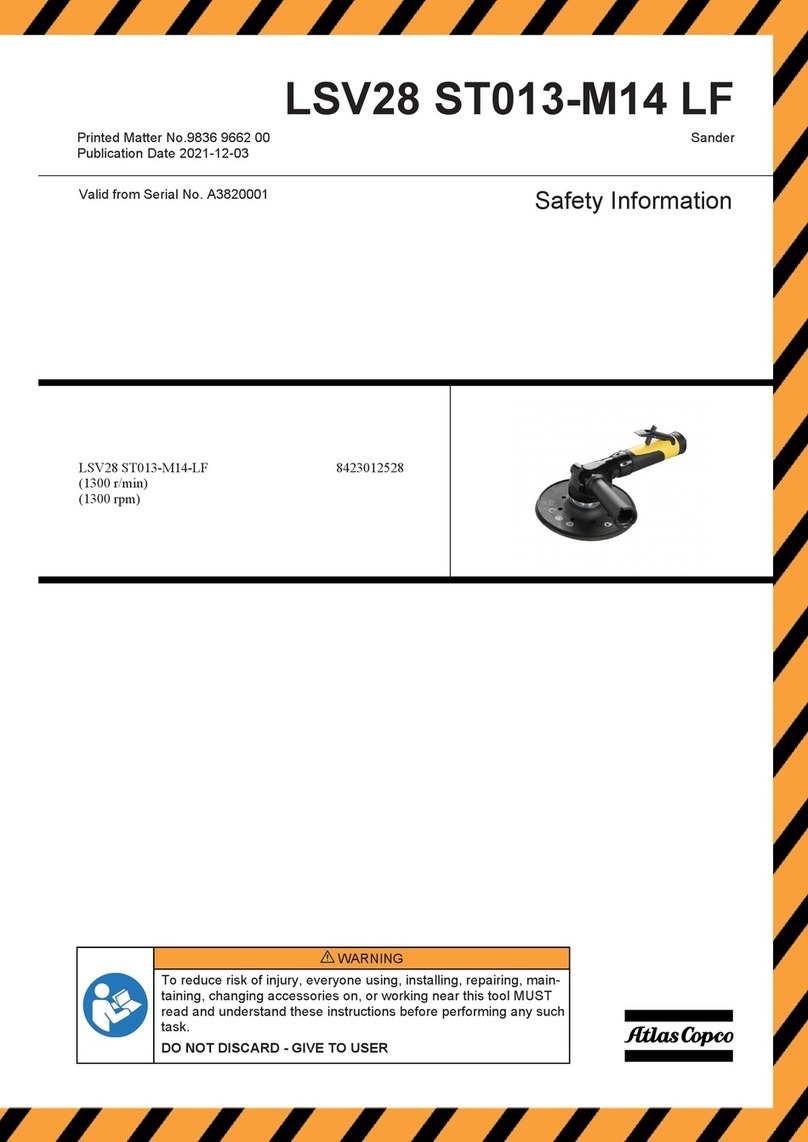SWISS TEC ST-150 BDS User manual

1
Operator’s Manual
ST-150 BDS
150 MM BELT & DISC SANDER
DKSH Hong Kong Limited
23/F Tower A, Southmark, 11 Yip Hing Street,
Wong Chuk Hang, Hong Kong
www.dksh.com

2
SAFETY INSTRUCTIONS
CAUTION:
Besides following the instructions mentioned in this manual, when using electric equipment you must always
observe all safety precautions to prevent risk of fire, electric shock and personal injury.
Read this instruction manual before use and keep it carefully.
As with all power tools there is a certain amount of hazard involved with the operator and his use of the tool.
Using the tool with respect and caution demanded as far as safety precautions are concerned will considerably
lessen the possibility of personal injury. However, if normal safety precautions are overlooked or completely
ignored, personal injury to the operator can develop. There are also certain applications for which this tool was
designed. We strongly recommend that this tool NOT be modified and/or used for any application other than for
which it was designed. If you have any questions relative to its application DO NOT use the tool until you have
written to us and we have advised you.
This tool has been designed for specific purposes. We recommend you not to modify it or use it for purposes
different from the ones for which it has been manufactured. If you have any doubts regarding specific
applications, do not use the machine before having contacted us and received our instructions.
GENERAL SAFETY INSTRUCTIONS
1. Keep the work surface clean. If the work area or surface is busy the probability of injuries is higher.
2. Do not use the machine in dangerous environment conditions. In order to prevent electric shock, do not
expose the machine to rain and do not use it in a damp area. Keep the work area illuminated. Do not use the
machine near gas or inflammable substances.
3. Connect the dust collection device. If the machine is provided with a dust collection device, make sure that
this system is connected and correctly used.
4. Keep unknown persons and children away from the machine. All unknown persons and children must keep
a safe distance from the work area.
5. Protect yourself from electric shock. Avoid any contact with earthing surfaces.
6. Handle the power supply cable with care. Do not pull the electric cable to disconnect it from the plug. Keep
the electric cable away from heat, oil and sharp edges.
7. Use extension cables designed for outdoor use. When using the machine outdoors, use only extension
cables suitable for outdoor use, having specific indications.
8. Be vigilant. Check carefully what you are doing, have good sense. Do not use the machine if you are tired.
9. Do not use the machine if you are having taken medicines, alcohol, drugs.
10. Avoid accidental starts. Be sure that the switch is on the OFF position before inserting the plug into the
socket.
11. Wear appropriate clothing. Do not wear loose-sleeved garments or pieces of jewelry which may get
caught in the moving parts. For outdoor use we recommend non-slip shoes. Use headgear to cover hair if
necessary.
12. Use always personal protection devices: wear protective goggles and masks in case dust or sawdust is
produced. Wear ear muffs or plugs in noisy areas. Wear gloves when handling parts with sharp edges.
13. Do not be off balance over the machine. Always keep stand firmly.
14. Ask for advices to expert and qualified people if you are not familiar with using such a machine.
15. Remove the tools you do not use from the workbench. If you do not use the tools, you must arrange them in
a dry area which is locked and away from the reach of children.

3
16. Do not force the tool. It will do the job better and be safer at the rate which it was designed.
17. Use right tool. Don’t force tool or attachment to do a job it was not designed for.
18. Block the piece. If possible, use C-clamps or a holder to fix the piece. It is safer than using only your hands.
19. Keep the tools in perfect conditions. Keep the tools sharp and clean to obtain better and safer results.
Follow the instructions to grease and change the accessories. Check regularly the electric cable and change it if
it is damaged. Keep the handles and the handgrips dry, clean from oil and grease.
20. Disconnect the tool from electricity if you do not use it, before maintenance and change of the accessories
or tools such as blades, drills, mills, etc.
21. Remove locking and adjustment wrenches from the workbench. Get used to check if the locking and
adjustment wrenches have been removed before starting it.
22. Check the parts of the tool to verify that there are not any damages. Before using the machine, check if the
safety devices or any other parts are damaged in order to be sure that it works properly and that it can
accomplish the tasks for which it has been designed. Check that the moving parts are aligned, do not stop and
are not broken. Check the assembly and any other condition that can influence the functioning of the machine.
Any part or protection damaged must be repaired or changed from an authorized after sales centre. Do not use
the machine if the switch does not work properly.
23. Use the machine, the tools and accessories in the way and for the purposes mentioned in this manual.
Different uses and parts can cause possible risks for the operator.
24. Get the machine repaired by a qualified person. This electric tool is in compliance with local safety
regulations. The machine must be repaired only by qualified people who use original spare parts, otherwise risks
may arise for the operator.
SPECIFIC SAFETY INSTRUCTIONS FOR BELT & DISC SANDER
1. Sander must be bolted down to a stand or workbench for stability.
2. Make sure there are no nails or foreign objects in the part of the work piece to be sanded.
3. Plan your work to avoid THROWBACKS – if the work piece catches on the sanding belt or disc and is torn
from your hand.
4. Make sure there is no debris between the work piece and its supports.
5. When sanding irregularly shaped work pieces, plan your work support so it will not slip and be pulled from
your hands.
6. Use extra caution with large, very small or awkward work pieces.
7. Never use this tool to finish pieces too small to hold by hand.
8. Use extra supports (tables, saw horses, work stands, etc, for any work pieces large enough to tip when not
held down to the table top.
9. DO NOT use another person as a substitute for a table extension, or as additional support for a work piece
that is longer or wider than the basic sander table, or to help feed, support, or pull the work piece.
10. When finishing on the disc, always press the work piece against the “Down” side of the disc. Sanding
against the side coming up from under the table could damage the work by making it “chatter”, or tear the work
from your hands and throw it.
11. Sand only one work piece at a time.
12. Find and read the WARNING label (see sample on right) mounted on the sander.
13. Clear everything except the work piece and related support devices off the table before turning the sander
on.
14. Plan the way you will hold the work piece from start to finish.
15. Avoid awkward operations and hand positions where a sudden slip could cause fingers or hand to move into
a sanding surface. Keep fingers away from where the belt goes into the dust trap.

4
16. Keep your face and body to one side, out of line with a possible throwback.
17. Before starting work, watch the sander while it runs. If it makes an unfamiliar noise or vibrates a lot, stop
immediately. Press the STOP button on sander. Unplug the sander. Do not restart until finding and correcting the
problem.
18. DO NOT FORCE TOOL. Press the work piece against the sanding material only hard enough to let it sand
without bogging down or binding.
19. Before freeing any jammed material ensure that you follow the next three steps.
- Press the red “STOP” button.
- Unplug the sander from the mains power supply.
- Wait for all moving parts to stop.
20. WARNING LABELS – It is important that labels and Health & Safety Warnings are not removed or painted
over. New labels are available from Customer Services.
21. MECHANICAL SAFETY – The security of all clamps and work holding devices should be checked before
switching on.
22. WOOD DUST – The fine particles of dust produced in sanding operations can be a long term health hazard
if excessive. Some imported hardwoods do give off highly irritant dust which causes a burning sensation. We
strongly recommend the use of a dust collector and dust mask/visor. Our Customer Services will be happy to
advise you on the correct unit for your needs.
BEFORE EACH USE
Inspect Your Sander
Disconnect the sander. To avoid injury from accidental starting unplug the sander before changing the setup,
sanding disc or belt or adjusting anything.
Check damaged parts. Check for
- Alignment of moving parts
- Binding or moving parts
- Broken parts
- Work parts that cause a gap larger than 1,5mm between work support and sanding surface.
- Worn or damaged electric cords
- Stable mounting
- Any other conditions that may affect the way the sander works.
If any part is missing, bent, or broken in any way, or any electrical parts don’t work properly, turn the sander off
and unplug the sander. REPLACE damaged, missing, or failed parts before using the sander again.
MAINTAIN TOOLS WITH CARE. Keep the sander clean for best and safer performance. Follow instructions for
lubricating.
REMOVE ADJUSTING KEYS AND WRENCHES from tool before turning it on.
To avoid injury from jams, slips or thrown pieces:
USE ONLY RECOMMENDED ACCESSORIES. Consult this owner’s manual for recommended accessories.
Follow the instructions that come with the accessories. The use of improper accessories may cause risk of
injury to person.
Adjust any work support to clear the sanding surface by no more than 1,5mm. When checking clearance
between the belt and work support, press the belt that against the metal beneath it.
Make sure all clamps and locks are tight and no parts have excessive play.
Keep work area clean. Cluttered areas and benches invite accident. Floor must not be slippery.
To avoid burns or other fire damage, never use the sander near flammable liquids, vapors or gases.

5
PLAN AHEAD TO PROTECT YOUR EYES, HANDS, FACE, EARS.
KNOW YOUR SANDER. Read and understand the operator’s manual and labels affixed to the tool. Learn its
application and limitations as well as the specific potential hazards peculiar to the tool.
To avoid injury from accidental contact with moving parts:
KEEP GUARDS IN PLACE and in working order.
Don’t do layout, assembly, or setup work on the sander while any parts are moving.
PLAN YOUR WORK
USE THE RIGHT TOOL. Don’t force tool or attachment to do a job it was not designed to do.
Caution: This machine is not designed for heavy deburring operations. When finishing metal sparks or
hot fragments could cause a fire. To avoid this:
- Disconnect any dust collecting hose from the sander
- Remove all traces of wood dust from inside the sander.
- Remove all traces of metal dust from inside the sander before sanding wood again.
Dress for safety.
Any power sander can throw foreign objects into the eyes. This can cause permanent eye damage. Wear safety
goggles.
Do not wear loose clothing, gloves, neckties or jewelry (rings, wrist watches). They can get caught and draw you
into moving parts.
WARRANTY
To ensure the proper functioning of its products, to meet the best standards of quality, durability and to ensure the
consumer / retail customer that any of our products are of no defects in materials and operation of the DKSH
Group is committed as follows:
1 YEAR WARRANTY ON ALL PARTS OF ELECTRICAL AND MECHANICAL
2 YEAR WARRANTY ON DEFECTS IN CONCEPT
This warranty will be invalid in case of misuse or abuse directly and indirectly, negligence, accidents, normal wear
and tear, repairs or modifications made by us or in case of lack of maintenance.
The warranty granted by the DKSH Group is limited to the period referred to above.
The warranty period is for an 8-hour daily operation. If you exceed this time frame, the warranty period is reduced
in proportion to the operating surplus, in each case up to a maximum of 3 months.
For the warranty to apply, you will need to send back for inspection by the product or part of it, prepaid, to an
authorized service center, established by our office. The goods must be accompanied by a document certifying
the purchase date and problem (invoice or receipt with a legible reported the item purchased, receipts will not be
accepted or illegible entries generic as "different", etc. where section 1 of course cannot be identify with certainty
the item purchased).
If as a result of our review will be found the defect, will repair or replace the product.
The warranty covers only the value of the machine, even if any failure is not warranted to be entitled to
compensation for loss of production or other economic losses related to non-use of the product itself.
We will then return the product repaired or replaced at the expense of DKSH same, but if as a result of control will
not find any fault, or if the defect has been caused by reasons that are not covered by the warranty, the purchaser
must bear the costs of filing and returning the consignment.
We reserve the right to make changes to parts, accessories and equipment, for any reason deemed necessary.
TECHNICAL SERVICE
All power tools and accessories are engineered and controlled by using the most modern and safe production
techniques. Nonetheless, in case of malfunctions, your machine has to be repaired by a Service Center
authorized by SWISStec.

6
ENVIRONEMENT PROTECTION
INFORMATION FOR USERS
In accordance with the implementation of Directives 2002/95/EEC, 2002/96/EEC and 2003/108/EEC, relative to
reducing the use of hazardous substances in electric and electronic appliances and the disposal of waste”,
please take note of the following:
The crossed out wheelie bin symbol found on the appliance or the packaging indicates that the product
must be disposed separately from ordinary household waste when it reaches the end of its working life.
The user must consign the unwanted appliance to an authorized waste disposal centre for electric and
electronic goods, or alternatively, hand it over to the relative dealer at the moment of purchasing a new
appliance of the same type on a basis of a one to one ratio.
Differentiated disposal to enable possible recycling or environmentally compatible elimination of the
appliance helps to limit undesirable effects on health and environment and promotes the reuse and/or
recycling of the materials that compose the appliance.
WARNING!
In accordance with the relative legislation in force in the country of use, sanctions will be imposed on
the user if the appliance is disposed of illegally.
SYMBOLS
Read and understand the instruction manual before use.
Risk of electric shock! Risk of personal injury by electric shock
Danger! Indicate risk of personal injury or severe material damage
Always wear protective goggles to avoid any spurts during the use of the machine.
Always wear a dust mask if the operation produces dust.
Always wear ear protective devices which protect you from noise while using the machine.
Plug out before maintain or adjustment
Product compliance with respective EU- standards
The tool is double insulated. This means that all the external metal parts are electrically insulated from
the mains power supply. This is done by placing insulation barriers between the electrical and mechanical
components making it unnecessary for the tool to be earthed..
It is forbidden to place your hands in the area marked with this sign, while the machine is running.
Do not expose to rain. Protect against humidity

7
Don’t litter, dispose the waste correctly
Damaged and liquidated electric or electronic devices have to be handed over in designated places for
recycling.
Cardboard wrapping can be disposed in designated places only.
ELECTRICAL CONNECTION
Use 230V ~ 50Hz alternate voltage equipped with a ground conductor to supply your machine.
Ensure that the power supply corresponds to this voltage, that it is protected by a differential and magnetic
thermal switch, and that the ground system is efficient. If your machine does not work when connected to a
socket, check carefully the power supply features.
WARNING: KEEP THE TOOLS AND THE EQUIPMENT AT A SAFE DISTANCE FROM CHILDREN
TECHNICAL SPECIFICATIONS
Model No ST-150 BDS
Motor 230V~50Hz / 400W
Disc speed 2850 minˉ¹
Belt speed 8,3 m/s
Grinding disc diameter Ø 150 mm
Sander belt size 100 x 914 mm
Disc worktable tilt 0º to 45º
Belt tilt 0º to 90º
Table size 150 x 230 mm
Weight (Gross/Net) 18 kg / 17 kg
The specifications in this manual are given as general information and are not binding. We reserve the right to
effect, at any time and without prior notice, changes or alterations to parts, fitting and accessory equipment
deemed necessary for any reason whatsoever.
REMOVAL OF PACKAGE AND CLEANING
The machine is delivered into a carton packaging. Take out the machine and all the components from the
packaging. Peel the protection off, where present: the protection can be removed with a damp, soft cloth. Do not
use acetone, petrol or painting solvents.
IMPORTANT: Always lift the machine by the base or by the transport handle, if present.
Should any part result defective or imperfect, do not use the machine in order not to compromise the
efficiency and the safety of the tool. Contact an authorized Service Centre to have the detective part
replaced.
Do not throw the carton before the machine is completely assembled.
WARNING:
By cleaning the machine, after unpacking, do not use petrol or other petrol-based solvents because
extremely inflammable.
The use of such products causes fire or explosion hazard.

8
In general, all solvents used for machine cleaning are toxic if inhaled or ingested.
Always operate in well-ventilated areas, away from potential sources of solvents. Wear a safety mask.
150 MM BELT & DISC SANDER IDENTIFICATION
A Base unit B Disc Guard
C Aluminum Disc (Sanding Disc Attached) D On/OFF switch
E Disc work Table F Miter Gauge
G Sander belt H Fence
I Belt cover K Dust port
L Angle scale M Table locking knob
ASSEMBLY
Mounting belt and disc sander to workbench
If belt and disc sander is to be used in a permanent location, it should be fastened securely to a firm supporting
surface such as workbench.
If mounting to a workbench, holes should be drilled through supporting surface of the workbench.
1. The unit should be bolted securely using M8 screws and hex nuts (not included). Screw length should be
50mm plus the thickness of bench top.
2. Locate and mark the holes through workbench.
3. Drill 4 x Ø10mm diameter holes through workbench.
4. Place belt and disc sander on workbench aligning holes on base with holes drilled in workbench.
5. Insert 4 M8 screws and tighten hex nuts.
A
B
C
D
E
F
G
H
I
K
L
M

9
Caution: To avoid injury from tool movement, supporting surface where belt and disc sander is
mounted should be examined carefully after mounting to insure that no movement during use can result. If any
tipping or walking in noted, secure workbench or support or supporting surface before operating belt and disc
sander.
Installing sander disc and disc guard
1. Locate sanding disc and peel backing from disc. Align perimeter of disc with plate and press disc firmly into
position all the way around.
Rotate the disc by hand and check to make sure the sandpaper is firmly attached to the disc.
Note! DO NOT turn the disc sander ON at this point.
2. Locate disc guard and two pan head screws from hardware bag.
3. Using Phillips type screwdriver, fasten the pan head screw securely applying slight pressure to thread the
holes.
Mounting the fence
The fence can be used to precisely guide the work piece on the belt sander.
1. Mount it, with the hex screw, spring washer and washer.
2. Square the fence and carefully tighten the screw.
Attaching the sanding table for the sanding disc
1. Lay the table upside down and align the table support with the holes in the table.
2. Take three hex bolts out of the hardware bag and put a lock washer and a flat washer on each bolt.
3. Screw the hex bolts with washers through the table support and into the disc table.

10
4. Insert the index pin into the upper hole on the base and tighten the lock knob.
Sanding table adjustments
The table stops have been pre-set at the factory. Follow the steps below if adjustments are needed.
1. Loosen lock knob and move table into the 90-degree position. Tighten lock knob and place a square against
the table and sander disc. The square should rest flat against the table and the disc.
Warning: To avoid jamming the work piece or fingers between the table and sanding surface, the table
edge should be a maximum of 1,5mm from sanding surface.
2. Always maintain a gap of approximately 1,5mm between the table edge, and disc. If adjustment is
necessary loosen the three hex bolts and adjust the table angle until there is no gap between the disc face and
the square.
3. Tighten the lock knob while holding the table perpendicular. Then adjust the pointer to zero mark on the
scale plate.
4. Use a 1,5mm drill bit as a spacer. Place the drill bit between the disc and the inside edge of the table. Hold
the table against the 1.5mm drill bit and tighten the three hex bolts.
Miter Gauge
The miter gauge needs to be adjusted perpendicular to the face of the wheel when it is mounted in the table slot.
To adjust miter gauge:
1. Use machinist’s square with one edge against the face of the miter gauge and the other against the disc
face.

11
2. Loosen the adjusting screw on the miter gauge and adjust it flush with the edge of the square.
3. Tighten the gauge adjusting screw, and verify the setting.
Note - Sometimes the tightening procedure can affect the adjustment.
4. Loosen the screw that secures the angle pointer and adjust the pointer to the 0° mark.
5. Retighten the screw that secures the angle pointer.
To adjust the sanding belt angle
1. Loosen the cap screw.
2. Raise the sanding belt to the desired angle and tighten the cap screw.
To install the sanding belt
1. Loosen the belt tension by pulling out the tensioning lever.
2. Slide the belt onto the drive drums and release the belt tensioning lever.
Note! Make sure that the arrow on the inside of the sanding belt points the same direction as the belt
rotation arrow on the machine.
Adjusting Sanding Belt Tracking
Warning! Before starting the sander, make sure you have performed the preceding assembly
and adjustment instructions, and you have read through the rest of the manual and are familiar with the
Belt
tension
lever

12
various functions and safety issues associated with this machine. Failure to follow this warning could
result in serious personal injury.
Once the sanding belt is installed, test the belt tracking to see if the belt slides off the drum.
To test the tracking:
1. Remove all tools from the sander.
2. Plug the sander into the power source. Press the switch ON and immediately turn the sander OFF.
3. If the sanding belt moves toward the disc, turn the tracking knob clockwise 1⁄4 turn.
4. If the sanding belt moves away from the disc, turn the tracking knob counter- clockwise 1⁄4 turn.
5. Press the switch ON and immediately turn the sander OFF. The belt is tracking properly if it stays centered
on the drive drums. If the belt moves to the side, return to step 3.
Note! Listen for any unusual noises, vibrations or rubbing while adjusting the tracking. If anything
sounds unusual, stop the sander immediately. Disconnect the machine from the power source and find the
source of the problem before operating further. If you cannot locate the source of an unusual noise or vibration,
feel free to contact our service department for help.
Dust Extraction
During sanding, hazardous dust may be formed. Therefore, it is strongly advised to connect the machine to a
vacuum cleaner or a dust extraction system. For commercial use this is demanded by law.
The dust collection for the sanding disc and the belt are fed into the same port that is located on the end of the
sander.
To connect your machine to a dust collection system place the hose over the dust port. Secure the hose in place
with a hose clamp.
OPERATION
Switching ON/OFF the belt and disc Sander
1. Make sure that the mains power in your area corresponds with the type labeled on the machine.
2. To switch ON the machine, press I and for switching OFF the machine press O.
This machine is equipped with a safety switch that contains a low voltage circuit breaker. This avoids
unintentionally starting up the machine.
Tracking
knob

13
To perform disc sanding operations:
Warning: Applying the work piece to the right side of the disc could cause work piece to fly up (kickback)
and result in an injury.
Please take note of the disc rotation (counter clockwise) and only work on the left side of the disc.
Applying the work piece to the left side of the disc will cause downward pressure against the table.
1. Set the angle of the table relative to the sanding disc. The angle can be set with the angle gauge on the disc
sander or with a protractor for greater accuracy.
2. When a 90° horizontal angle is required, place one surface of the work piece firmly against the face of the
miter gauge (set at 0°), with the other surface against the face of the disc.
3. Use light pressure and move the work piece slowly back and forth across the disc to prevent the work piece
from burning and to prevent excessive loading of the sanding disc.
Note - For sanding curves or irregular shapes, remove the miter gauge from the disc table.
Always keep the work piece on the side of the wheel that is rotating down toward the table. This will keep
the work piece from flying out of your hands from the rotational forces.
The most efficient way to get a perfect miter is to cut the work piece slightly long and sand it to the desired
dimension. Miter sanding can be done easily with the miter gauge:
To perform miter sanding operations:
1. Loosen the knob on the miter gauge and adjust the angle to the desired point. Tighten the knob.
2. Slide the miter gauge into its slot and use it to hold your work piece in position.
Note - The miter gauge can be used in either direction in the slot to achieve the proper relation of
the work piece to the disc.
3. With light, but firm pressure, push the work piece slowly into the downspin side of the rotating disc.
To perform angle sanding operations:
1. Loosen the lock knob securing the table.
2. Use the angle gauge to achieve the desired table angle and tighten the knob.

14
Note - The disc table can be positioned from 0° to 45°, relative to the plane of the sanding surface.
Whenever possible, sand with an open angle where there is plenty of clearance between the disc and the
table. This will avoid trapping the work piece between the sanding surface and the table.
Warning: To avoid jamming the work piece or fingers between the table and sanding surface, the table
should repositioned on the table support to retain a maximum of 1,5mm distance between sanding surface and
table.
3. Slide the miter gauge into its slot and use it to hold your work piece in position.
4. With light, but firm pressure, push the work piece slowly into the downspin side of the rotating disc.
To perform horizontal sanding operations:
1. Turn the power ON and allow the sander to reach full speed.
2. Place the work piece against the surface of the sanding belt. Hold the work piece firmly with both hands but
keep fingers away from the sanding surface.
3. Move the work piece across the surface of the belt for even belt wear.
4. Use the fence to prevent the work piece from being thrown off by the rotation of the sanding belt.
Warning: Hold the work piece firmly when the fence is removed to prevent the work piece from
being thrown. Keep bystanders away from the machine while in operation.
5. Remove the fence from the sander if the work piece is longer than the sanding bed.
To perform curved sanding operations:
1. Turn the power ON and allow the sander to reach full speed.
2. Hold the work piece against the end of the sanding belt. Move the work piece slowly across the entire
surface of the belt.
The disc sanding table can be removed and installed on the sanding belt bed when the sanding belt bed is
vertical. This gives the operator more working room when using the sanding belt.

15
To install the table on the sanding belt bed:
1. Raise the belt bed to vertical and remove the fence.
2. Remove the disc sanding table.
3. Place the index pin of the disc sanding table in the upper hole in the sanding belt table.
4. Rotate the sanding table perpendicular to the sanding belt and screw in the lock knob.
MAINTENANCE
WARNING!
-Before any repair or maintenance on the machine, disconnect the feeder cable. This has to
remain disconnected every time you set or repair the machine.
-To prevent electrical shocks and fire, always use spare parts with the same characteristics.
-Used, cut or damaged cables have to be immediately replaced.
To replace and tension the drive belt:
Disconnect the machine from the power source!
1. Remove the drive belt cover plate.
2. Loosen the three tensioning screws of the drive belt and slide the drive belt housing down and remove the
old belt.
3. Place the new belt first on the lower drive pulley and then on the upper one. Lightly tighten the tensioning
screws.
4. Insert a screwdriver into the adjustment opening and tension the drive belt by moving the screwdriver. After
that, tighten the three tensioning screws.
Drive
belt
housing

16
5. Check the tension of the drive belt by compressing it in the middle. The drive belt has the correct tension
when it can be compressed by about 5 mm. If the belt is too slack, it may creep on the wheels and may be
destroyed. If the belt is too tight it will overload the motor and put excessive stress on all bearings. After that,
reattach the drive cover.
Lubricating sleeve bearings
Lubricate the sleeve bearing with 30 WT oil every 10 hours of operation. No other lubrication is necessary for this
machine.
Disconnect the machine from the power source!
1. Remove the sanding belt.
2. Apply two or three drops of oil in the hole at the end of the idler pulley.
Note! DO NOT apply extra oil. Too much oil can cause the belt to slip.
Following maintenance schedule ensures that your machine is safe and performs accurately.
Check the following items before you use the disc sander:
Loose mounting bolts.
Worn loose, or damaged sanding disc.
Worn or damaged wires.
- Any other condition that could hamper the safe operation of this machine.
Perform the following tasks at the scheduled time intervals:
After Each Use
Wipe off the sawdust build-up from the table surface.
Regularly clean the dust extraction openings with a stiff brush.
Use a maybe slightly moistened cloth to clean the machine. Carefully dry the machine before the next
use. Do not use solvents, abrasives or aggressive chemicals.
Do not allow liquids of any kind to enter the machine and do not immerse any part of the machine in
liquids.
Weekly
Wipe a lubricant onto the disc table.
TROUBLE SHOOTING
DANGER! Many accidents happen particularly in connection with problems and malfunctions. Therefore
please note:
Always unplug before servicing.
Check that all safety devices are operational again after each fault service.
Trouble Possible cause Suggested corrective action
Grains easily rub off the
belt or disc.
1. Sanding belt/disc has been
stored in an incorrect environment.
2. Sanding belt/disc has been
smashed or folded.
1. Store sanding belt/disc away from
extremely hot or dry temperatures.
2. Store sanding belt/disc flat not bent or
folded.

17
Deep sanding grooves
or scars in work piece.
1. Sanding belt/disc grit is too
coarse for the desired finish.
2. Work piece sanded across the
grain.
3. Too much sanding force on
work piece.
4. Work piece held still against the
belt/disc.
1. Use a finer grit sanding belt/disc.
2. Sand with the grain.
3. Reduce pressure on work piece while
sanding.
4. Keep work piece moving while sanding on
the belt/disc.
Sanding surface clogs
quickly or burns.
1. Too much pressure against
belt/disc.
2. Sanding softwood.
1. Reduce pressure on work piece while
sanding.
2. Use different stock. Or accept the
characteristics of the stock and plan on
cleaning/replacing belts frequently.
Glazed sanding
surfaces.
1. Sanding wet stock.
2. Sanding stock with high residue.
1. Dry stock properly before sanding.
2. Use different stock. Or accept the
characteristics of the stock and plan on
cleaning/replacing belts/discs frequently.
Motor will not start. 1. Low voltage.
2. Open circuit in motor or loose
connections.
1. Check power supply for proper voltage.
2. Inspect all lead connections on motor for
loose or open connections.
Motor will not start;
fuses or circuit breakers
blow.
1. Short circuit in line cord or plug.
2. Short circuit in motor or loose
connections.
3. Incorrect fuses or circuit
breakers in power line.
1. Inspect cord or plug for damaged
insulation and shorted wires.
2. Inspect all connections on motor for loose
or shorted terminals or worn insulation.
3. Install correct fuses or circuit breakers.
Motor overheats. 1. Motor overloaded.
2. Incorrect usage of machine.
3. Air circulation through the motor
restricted.
1. Reduce load on motor.
2. Reduce the applied load on the machine.
3. Clean out motor to provide normal air
circulation.
Motor stalls (resulting in
blown fuses or tripped
circuit).
1. Short circuit in motor or loose
connections.
2. Low voltage.
3. Incorrect fuses or circuit
breakers in power line.
4. Motor overloaded.
1. Inspect connections on motor for loose or
shorted terminals or worn insulation.
2 Correct the low voltage conditions.
3. Install correct fuses or circuit breakers.
4. Reduce load on motor.
Burn marks on work
piece.
1. Using too fine of sanding grit.
2. Using too much pressure.
3. Work held still for too long.
1. Use a coarser grit sanding belt/disc.
2. Reduce pressure on work piece while
sanding.
3. Do not keep work piece in one place for
too long.
Machine slows when
operating.
1. Applying too much pressure to
work piece.
2. Undersized circuit or using ext
cord.
1. Sand with less pressure - let the movement
of the belt/disc do the work.
2. Make sure circuit wires are proper gauge &
don’t use ext cords!

18
Machine vibrates
excessively.
1. Incorrect motor mounting.
2. Incorrect sanding belt tension.
3. Weak or broken tension spring.
4. Idler roller is too loose.
5. Broken/defective sanding
belt/disc.
1. Check/adjust motor mounting.
2. Make sure tension lever is in tensioning
position. Follow belt tensioning instructions in
this manual.
3. Replace spring.
4. Adjust idler roller.
5. Replace sanding belt/disc.
Work piece frequently
gets pulled out of your
hand.
1. Not supporting the work piece
against the fence.
1. Use the fence to support work piece.
Work piece lifts up from
sanding disc table.
1. Sanding on the up spinning side
of the disc.
1. Sand on the down spinning side of the
disc.
PART DIAGRAM

19
PART LIST
Pos. No.: Part Name Qty. Pos. No.: Part Name Qty.
1 Knob 1 36 Support, table 1
2 Washer, Rubber 1 37 Label, scale 1
3 Washer, Notched 1 38 Cord with plug 1
4 Bed 1 39 Motor 1
5 Screw, flat cross, M5 – 35 1 40 Connector, wire 1
6 Screw, hex, M6 – 14 4 41 Nut, hex, M6 3
7 Lock washer 4 42 Base 1
8 Washer ø6,5xø17,8x1,6 5 43 Belt, timing drive 1
9 Fence 1 44 Screw, flat cross, M5 – 10 3
10 Belt, Sanding 100x914 1 45 Washer 2
11 Lock washer, Helical M5 3 46 Pulley, drive 1
12 Screw, pan head, M5 – 8 4 47 Screw, pan head, M6 – 25 3
13 Drum, Drive 1 48 Washer M6x12x1,6 3
14 Screw, socket, M8 – 10 2 49 Pulley, Idler 1
15 Cap, bearing 1 50 Screw, flat head, M5 – 25 2
16 Bearing, with flat washer 2 51 Support, bearing 1
17 Spacer, bearing 1 52 Cover, belt 1
18 Housing, switch 1 53 Support, bed 1
19 Lock washer Ext. M5 10 54 Nut, square M8 1
20 Screw, pan head, M8 – 16 5 55 Bumper, rubber 1
21 1 56 Screw, hex socket, M8 – 25 1
22 Switch 1 57 Lock knob 1
23 Lead 1 58 Ring, retaining M12 4
24 Screw, pan cross, ST4,2 3 59 Shaft, drive 1
25 Cover, switch box 1 60 Nut, Hex, flange M5 1
26 N/A 61 Spacer, guide 1
27 Pad, 150mm Sandpaper 1 62 Spring, index 1
28 Screw, pan, M6 – 12 1 63 Guide, drum 1
29 Lock washer, Helical, M6 1 64 Shaft, idler 1
30 Disc 1 65 Drum, idler 1
31 Screw, pan cross, ST4,2 2 66 Lever, tension 1
32 Guard, disc 1 67 Spring, tension 1
33 Shroud, disc 1 68 Spacer, lever 1
34 Collector, dust 1 69 Washer M5x15x1,2 10
35 Table 1 70 Miter gauge 1

20
EC- DECLARATION OF CONFORMITY
We, DKSH Hong Kong Limited, 23/F Tower A, Southmark, 11 Yip Hing Street, Wong Chuk Hang,
Hong Kong,
declare under our sole responsibility, that the machinery
Factory Product name: BDS 46 – 150mm Belt & Disc Sander
Function: Grinding Material
Model: ST – 150 BDS
Type: Electric Power Tool
Article number: 77.890.89004.11
Year of production: 2011
is in conformity with all the relevant provisions of Directives:
2006/42/ EC (Machinery directive),
2004/108/ EC (EMC),
2002/95/ EC (RoHS directive),
2002/96/ EC (WEEE directive)
and tested in accordance with below standards:
EN 61029-1:2009
EN 55014-1:2006
EN 55014-2:1997+A1+A2
EN 61000-3-2:2006+A1+A2
EN 61000-3-3:2008
EN 60204-1:2005/A1:2008
Hong Kong, 15.07.2011 Managing Director
Authorized to compile the technical file
DKSH Hong Kong Limited
23/F Tower A, Southmark, 11 Yip Hing Street, Wong Chuk Hang,
Hong Kong
www.dksh.com
Table of contents
Popular Sander manuals by other brands
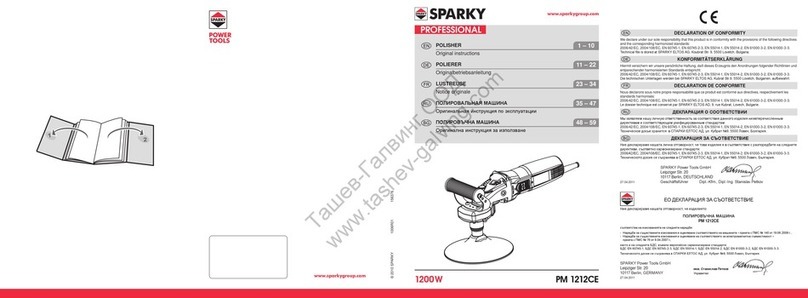
Sparky Group
Sparky Group PM 1212CE Original instructions

Nitto Kohki
Nitto Kohki Belton B-10CL instruction manual

VONROC
VONROC PM505AC Original instructions
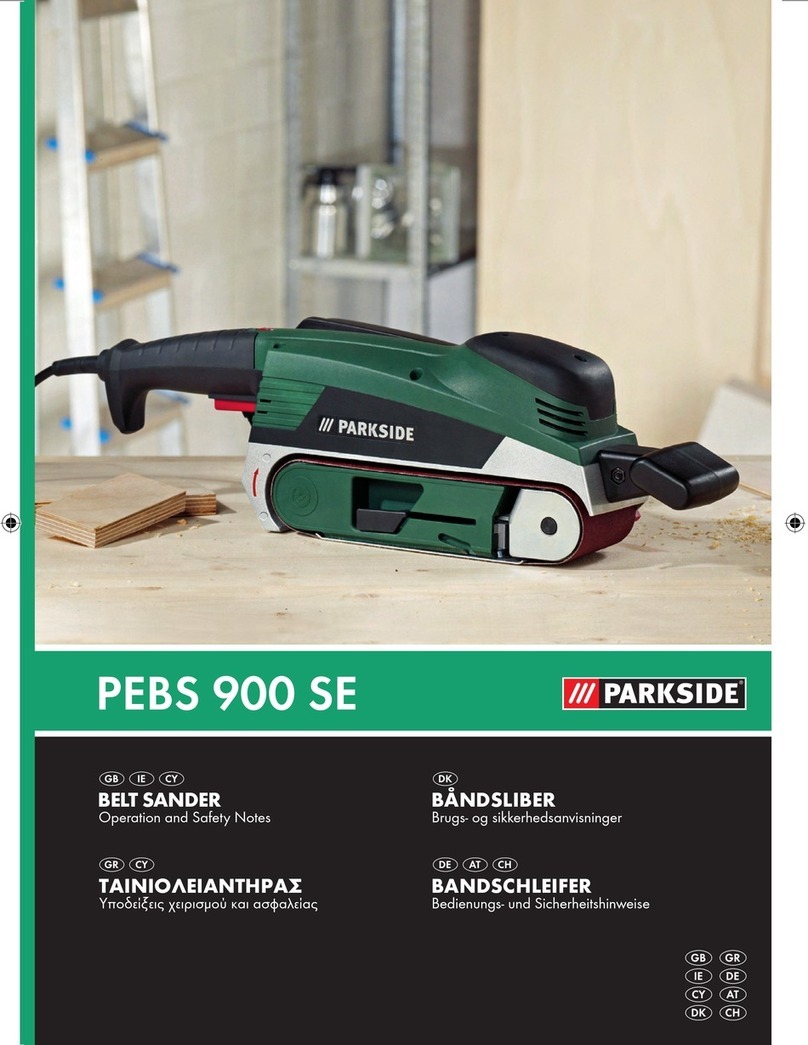
Parkside
Parkside KH 3020 BELT SANDER manual
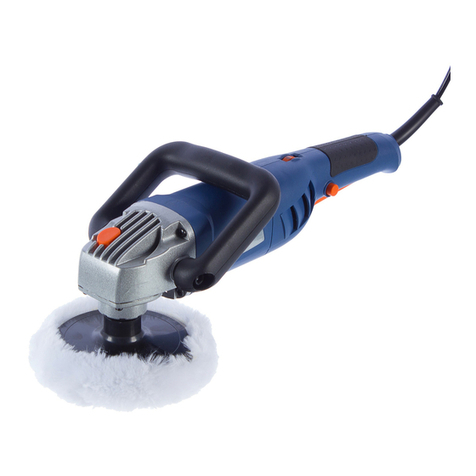
Dexter Power
Dexter Power A7187-DP-1 Legal and Safety Instructions

Festool
Festool ROTEX RO 125 FEQ instruction manual
